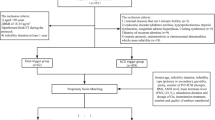Abstract
Objective
It is well known that a dual trigger treatment can improve clinical outcomes of in vitro fertilization (IVF) in high or normal ovarian responders. However, it is not clear whether dual triggering also benefits patients with diminished ovarian reserve (DOR). The aim of this study was to investigate whether a dual trigger treatment of gonadotropin-releasing hormone (GnRH) agonist combined with human chorionic gonadotropin (hCG) for final follicular maturation improves the cumulative live birth rate (CLBR) during the GnRH-antagonist cycle in patients with DOR.
Methods
This retrospective study included patients with DOR who received a GnRH-antagonist protocol during IVF and intracytoplasmic sperm injection (IVF-ICSI) cycles at Peking University People’s Hospital from January 1, 2017 through December 31, 2017. Oocyte maturation was triggered by GnRH combined with hCG (n=110) or hCG alone (n=71). Embryos were transferred on the third day after oocyte retrieval or during a subsequent freeze-thaw cycle. Patients were followed up for 3 years.
Results
The dual trigger treatment did not affect CLBR, which is an overall determinant of the success rate of assisted reproductive technology (ART). Women in the dual trigger group had significantly higher rates of fertilization than those in the hCG group (90.1% vs. 83.9%, P=0.040).
Conclusion
Dual trigger with GnRH agonist and hCG did not improve CLBR in patients with DOR, but did slightly improve fertilization rate, oocyte count, and embryo quality.
Similar content being viewed by others
References
Patrizio P, Vaiarelli A, Levi Setti P, et al. How to define, diagnose and treat poor responders? Responses from a worldwide survey of IVF clinics. Reprod Biomed Oniline, 2015,30(6):581–592
Gorgy A, Naumann N, Bates S, et al. Assisted conception following poor ovarian response to gonadotrophin stimulation. Br J Obstet Gynaecol, 1997,104(12):1420–1421
Griffin D, Benadiva C, Kummer N, et al. Dual trigger of oocyte maturation with gonadotropin-releasing hormone agonist and low-dose human chorionic gonadotropin to optimize live birth rates in high responders. Fertil Steril, 2012,97(6):1316–1320
Shapiro B, Daneshmand S, Garner F, et al. Comparison of “triggers” using leuprolide acetate alone or in combination with low-dose human chorionic gonadotropin. Fertil Steril, 2011,95(8):2715–2717
Lin M, Wu F, Lee R, et al. Dual trigger with combination of gonadotropin-releasing hormone agonist and human chorionic gonadotropin significantly improves the live-birth rate for normal responders in GnRH-antagonist cycles. Fertil Steril, 2013,100(5):1296–1302
Schachter M, Friedler S, Ron-El R, et al. Can pregnancy rate be improved in gonadotropin-releasing hormone (GnRH) antagonist cycles by administering GnRH agonist before oocyte retrieval? A prospective, randomized study. Fertil Steril, 2008,90(4):1087–1093
Lin M, Wu F, Hwu Y, et al. Dual trigger with gonadotropin releasing hormone agonist and human chorionic gonadotropin significantly improves live birth rate for women with diminished ovarian reserve. Reprod Biol Endorin, 2019,17(1):7
Kim S, Kim T, Park J, et al. Effect of a dual trigger on oocyte maturation in young women with decreased ovarian reserve for the purpose of elective oocyte cryopreservation. Clin Exp Reprod Med, 2020,47(4):306–311
Cummins J, Breen T, Harrison K, et al. A formula for scoring human embryo growth rates in in vitro fertilization: its value in predicting pregnancy and in comparison with visual estimates of embryo quality. J In Vitro Fert Embryo Transf, 1986,3(5):284–295
Yin H, Jiang H, He R, et al. The effects of blastocyst morphological score and blastocoele re-expansion speed after warming on pregnancy outcomes. Clin Exp Reprod Med, 2016,43(1):31–37
Lamb J, Shen S, McCulloch C, et al. Follicle-stimulating hormone administered at the time of human chorionic gonadotropin trigger improves oocyte developmental competence in in vitro fertilization cycles: a randomized, double-blind, placebo-controlled trial. Fertil Steril, 2011,95(5):1655–1660
Cohen J, Chabbert-Buffet N, Darai E. Diminished ovarian reserve, premature ovarian failure, poor ovarian responder—a plea for universal definitions. J Assist Reprod Genet, 2015,32(12):1709–1712
Haas J, Ophir L, Barzilay E, et al. Standard human chorionic gonadotropin versus double trigger for final oocyte maturation results in different granulosa cells gene expressions: a pilot study. Fertil Steril, 2016,106(3):653–659.e1
Yu B, Ruman J, Christman G. The role of peripheral gonadotropin-releasing hormone receptors in female reproduction. Fertil Steril, 2011,95(2):465–473
Li H, Lee V, Lau E, et al. Cumulative live-birth rate in women with polycystic ovary syndrome or isolated polycystic ovaries undergoing in-vitro fertilisation treatment. J Assist Reprod Genet, 2014,31(2):205–211
Luke B, Brown M, Wantman E, et al. Cumulative birth rates with linked assisted reproductive technology cycles. N Engl J Med, 2012,366(26):2483–2491
Acknowledgements
The authors thank the nurses and laboratory staff of the Department of Assisted Reproduction, Peking University Peoples’ Hospital for their contribution to this study.
Author information
Authors and Affiliations
Corresponding authors
Ethics declarations
The authors have no conflict of interest.
Additional information
This study was supported by grants from the Scientific Research Development Fund of Peking University People’s Hospital (No. RDY2020-27), Clinical Medicine Plus X - Young Scholars Project, Peking University, and the Fundamental Research Funds for the Central Universities (No. PKU2021LCXQ020).
Rights and permissions
About this article
Cite this article
Ren, Ym., Wang, Yb., Fu, M. et al. Effect of Dual Trigger In Vitro Fertilization and Intracytoplasmic Sperm Injection During the Gonadotropin-releasing Hormone-Antagonist Cycle on Final Oocyte Maturation and Cumulative Live Birth Rate in Women with Diminished Ovarian Reserve. CURR MED SCI 42, 1066–1070 (2022). https://doi.org/10.1007/s11596-022-2608-2
Received:
Accepted:
Published:
Issue Date:
DOI: https://doi.org/10.1007/s11596-022-2608-2



